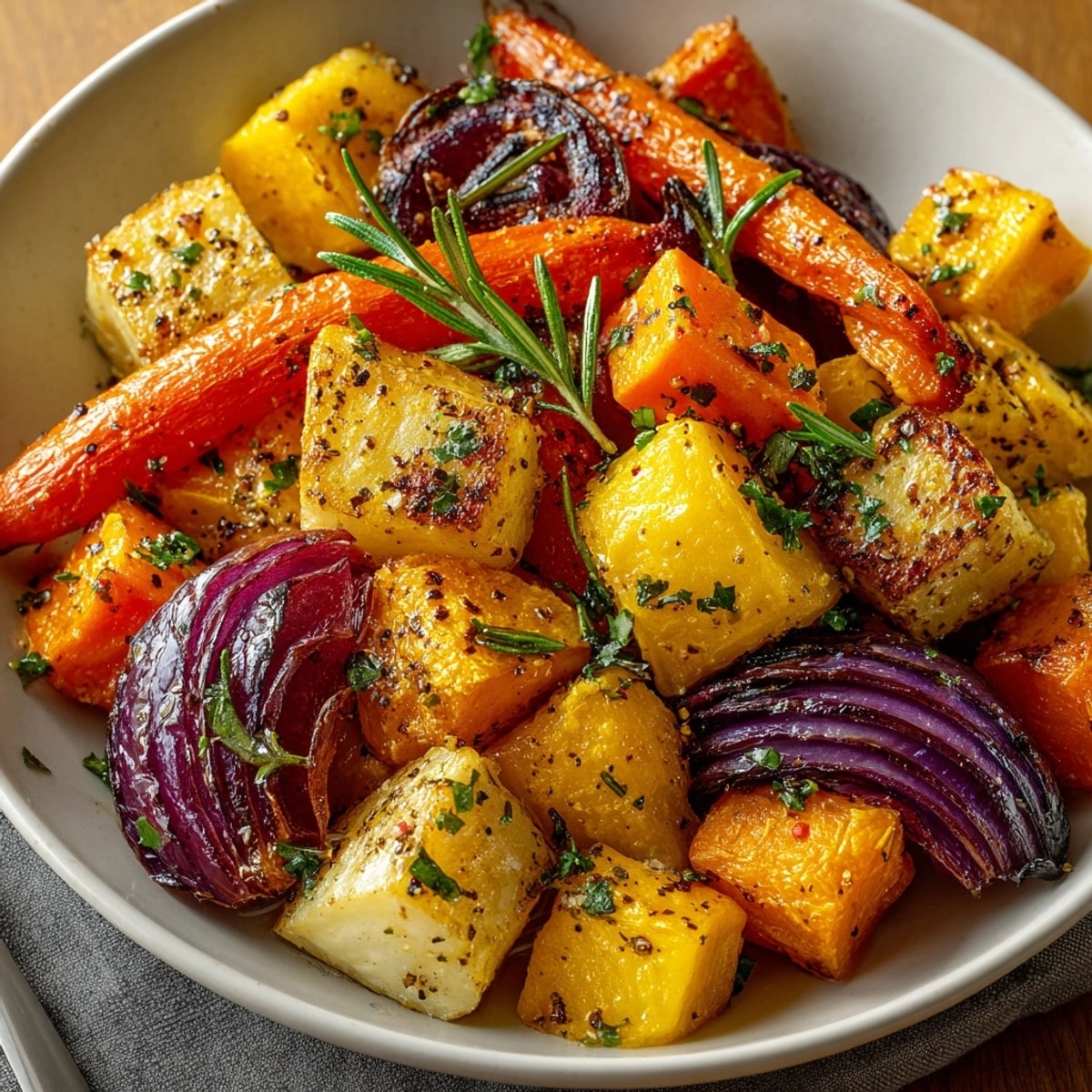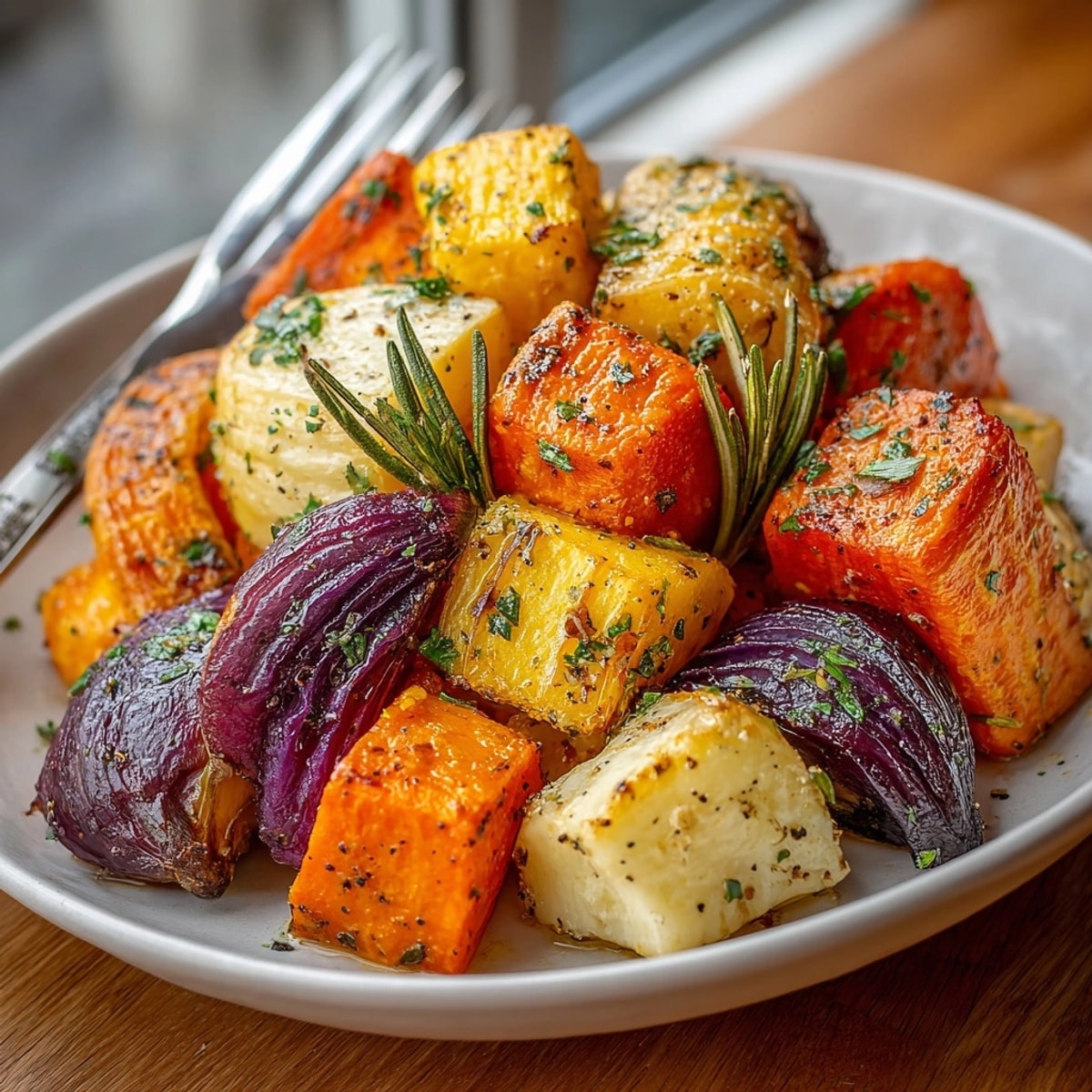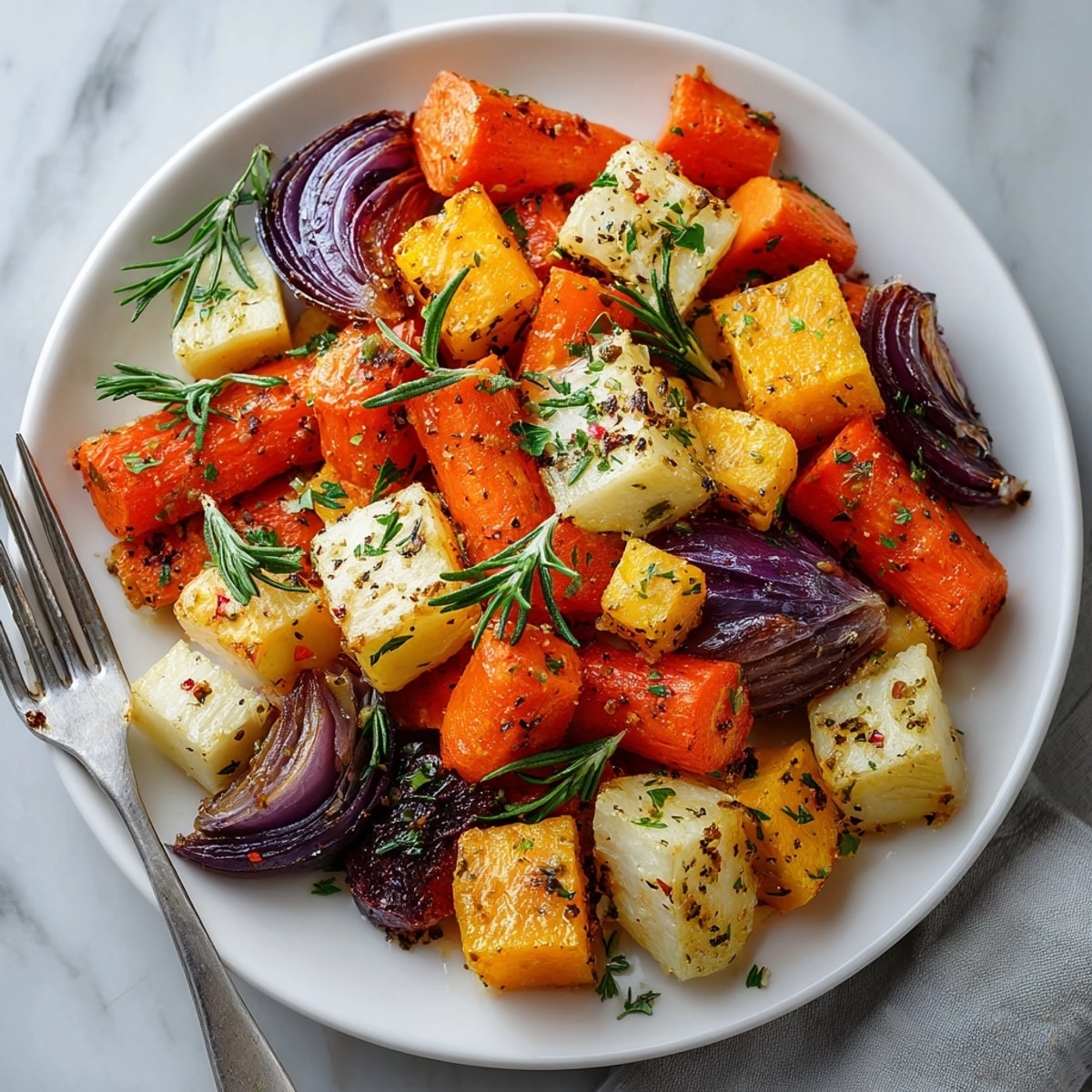 Save
Save This vibrant medley of seasonal root vegetables transforms humble ingredients into a spectacular side dish. Roasted to caramelized perfection with aromatic rosemary, these vegetables develop deep, complex flavors that elevate any meal from ordinary to extraordinary. My garden's autumn harvest finds its perfect expression in this simple yet stunning recipe.
I first created this recipe when hosting my first Thanksgiving as a newlywed. Years later, it remains our most requested holiday side dish, though we enjoy it throughout the colder months whenever we crave something hearty yet wholesome.
Ingredients
- Carrots: provide natural sweetness and vibrant color. Look for firm carrots with bright orange hues
- Parsnips: offer a subtle peppery sweetness that balances the dish. Choose medium sized ones as very large parsnips can have woody cores
- Sweet potato: adds creamy texture and caramelizes beautifully. Select ones with unblemished skin and uniform color
- Rutabaga or turnip: contributes a slight peppery bite that cuts through the sweeter vegetables. Smaller ones tend to be less bitter
- Red onions: develop incredible sweetness when roasted. Look for firm onions with dry papery skins
- Olive oil: helps vegetables caramelize. Use good quality extra virgin for best flavor
- Fresh rosemary: provides aromatic pine notes. If using dried, crush between your fingers to release oils
- Sea salt: enhances all flavors. Flaky sea salt works particularly well for finishing
- Black pepper: adds gentle heat. Freshly ground makes a noticeable difference
- Garlic: becomes sweet and mellow when roasted. Choose plump cloves without green sprouts
Instructions
- Preheat and Prepare:
- Begin by heating your oven to 425°F. This high temperature is crucial for developing caramelization and those delicious crispy edges. While the oven heats, line your largest baking sheet with parchment paper. This prevents sticking and makes cleanup infinitely easier. If you have two smaller sheets, use both rather than crowding one pan.
- Vegetable Preparation:
- Take your time cutting vegetables into uniform pieces approximately one inch in size. Consistency is key for even cooking. The sweet potato and rutabaga may require slightly more force when cutting, so use a sharp knife and stable cutting surface. For onions, cut through the root end, then slice each half into three wedges, keeping the root intact to hold layers together.
- Seasoning Magic:
- In your largest mixing bowl, combine all cut vegetables. Drizzle with olive oil first, using your hands to ensure every piece gets a light coating. This oil barrier prevents herbs from burning. Next, add the minced garlic, chopped rosemary, salt and pepper. Toss thoroughly until every vegetable piece shows specks of herb and seasoning. Take an extra minute here to ensure even distribution.
- Arrange for Success:
- Transfer seasoned vegetables to your prepared baking sheet, taking care to arrange them in a single layer with small spaces between pieces. Overcrowding leads to steaming rather than roasting. Use a spatula to scrape every bit of seasoned oil from the bowl onto the vegetables. Position the pan in the center of your oven where heat circulation is most even.
- Roasting Perfection:
- Roast for exactly 20 minutes, then remove from oven and use a spatula to carefully turn vegetables. Pay special attention to the edges of your baking sheet, redistributing any pieces that are browning too quickly toward the center. Return to oven for another 15 to 20 minutes, watching closely during the final minutes. Perfect roasted vegetables should be fork tender with golden caramelized edges.
- Final Touches:
- Remove from oven when vegetables yield easily to a fork but still maintain their shape. Taste a smaller piece and adjust seasoning if needed. For special occasions, consider finishing with a light sprinkle of flaky sea salt and fresh rosemary leaves. Allow to rest for 3 to 5 minutes before transferring to a serving dish, which allows flavors to settle and caramelization to fully develop.
 Pin it
Pin it The sweet potato is truly the unsung hero of this dish. While many people focus on the aromatic rosemary, I find the sweet potato provides crucial creamy texture that balances the firmer vegetables. My grandmother always included sweet potato in her roasted vegetables, insisting they were nature's candy when caramelized properly.
Storage Tips
These roasted vegetables maintain their delicious flavor for up to four days when stored properly in an airtight container in the refrigerator. For best results, allow them to cool completely before refrigerating to prevent condensation which can make them soggy. To reheat, spread in a single layer on a baking sheet and warm in a 350°F oven for about 10 minutes until heated through. Avoid microwaving if possible as it can make the vegetables soft and lifeless.
Seasonal Adaptations
Winter Version: Add butternut squash cubes and substitute thyme for rosemary. Drizzle with a tablespoon of maple syrup before roasting for additional warmth and sweetness perfect for holiday tables.
Spring Version: Use baby carrots, new potatoes, and spring onions instead. Add asparagus pieces during the last 10 minutes of roasting. Finish with fresh dill and lemon zest for brightness.
Fall Version: Incorporate chunks of acorn squash and apple pieces. Add a pinch of cinnamon and nutmeg to the seasoning blend for a harvest flavor profile that pairs beautifully with poultry.
Serving Suggestions
Transform these roasted vegetables from side dish to main event by serving them atop creamy polenta with a sprinkle of goat cheese. The contrast between the soft polenta and caramelized vegetables creates a restaurant worthy vegetarian entree.
Create a stunning grain bowl by using these vegetables as a topping for quinoa or farro. Add a protein like chickpeas or grilled chicken, then finish with a drizzle of tahini dressing for a complete meal.
For an elegant presentation at dinner parties, serve these vegetables on a platter with a dollop of herbed yogurt on the side. The cool, tangy yogurt provides a delightful contrast to the warm, caramelized vegetables.
 Pin it
Pin it These roasted root vegetables are a testament to simple ingredients reaching their full potential. Their caramelized sweetness and herbaceous aroma make them a truly unforgettable side dish.
Frequently Asked Questions
- → Which root vegetables work best for roasting?
Carrots, parsnips, sweet potatoes, rutabaga, and red onions roast well, but you can substitute with beets, potatoes, or celery root for variety.
- → How do you enhance the flavors of roasted vegetables?
Fresh rosemary, garlic, olive oil, and sea salt create aromatic undertones while roasting brings out natural sweetness and caramelization.
- → Can I prepare this dish in advance?
Yes. Chop vegetables ahead and refrigerate. Toss with oil and seasonings just before roasting for best texture.
- → How can I achieve extra crispiness?
Broil the vegetables for the last 2–3 minutes of roasting, watching closely to avoid burning the edges.
- → What can I serve with roasted root vegetables?
They pair deliciously with grain bowls, roasted meats, or as a topping for salads and plant-based mains.
- → Is this dish suitable for special diets?
Yes, it's vegan and gluten-free, but always confirm all ingredient labels for pre-packaged items.